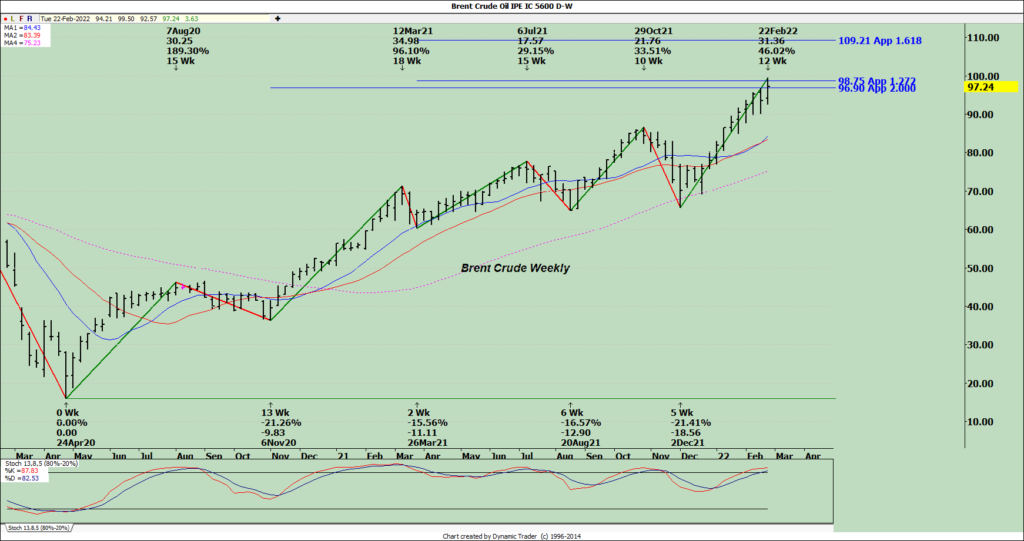Exactly why this should have come as a surprise to anyone is slightly baffling, but with confirmation that Russia has moved into parts of Eastern Ukraine over the weekend, a number of commodity markets have jolted into higher territory to begin the week as well. After building up troops at the border for the past six weeks, it seemed a foregone conclusion that Putin would order the troops in, which at this point is being dubbed a mission to help the separatists in those areas to break free. I suspect next thing; he may try and pitch this as a humanitarian move. Regardless, for many, the question is now, will this be similar to the takeover of Crimea back in 2014, where they advanced no further, or does he have something bigger in mind, and hence the need to add risk premium? He is receiving enough pushback from the international community that I suspect it is the first of these two. Still, long term, if I were a resident of Ukraine, I would not be too optimistic about the longer-term prospects of independence.
Grain and soy markets are not the only commodities that have extended strength this morning, as crude oil has poked in higher highs as well. Note that the spot contract for Brent has moved to within $.50 of tagging the psychological level of $100 per barrel. Putin has assured the world that there will be no disruption of oil/gas coming from Russia, which is minor consolation at this point, and Germany has announced they are halting the Nord Stream 2 gas pipeline. Needless to say, all of this just heightens the uncertainty for the time being. That said, we should never lose sight of the fact that higher prices will encourage investment and output in other parts of the world, i.e., shale business in North America, and when this current risk subsides, prices will tumble.
Grain and soy markets are not the only commodities that have extended strength this morning, as crude oil has poked in higher highs as well. Note that the spot contract for Brent has moved to within $.50 of tagging the psychological level of $100 per barrel. Putin has assured the world that there will be no disruption of oil/gas coming from Russia, which is minor consolation at this point, and Germany has announced they are halting the Nord Stream 2 gas pipeline. Needless to say, all of this just heightens the uncertainty for the time being. That said, we should never lose sight of the fact that higher prices will encourage investment and output in other parts of the world, i.e., shale business in North America, and when this current risk subsides, prices will tumble.
While it is difficult to tell by most news out this morning, there are still stories around that impact the grain and soy markets, the most prominent of which is the situation in South America. Rain appears to be on the way in Argentina for the latter part of this week and into the weekend, but for many crops will be too little, too late to do much more than halt deterioration. 59% of the early planted corn in that country has reached the filling stage, and 29% is now mature. Of the later planted corn, 60% is at the pollination stage. The crop is rated 26% poor/very poor, 55% fair, and just 19% good/excellent. Dr. Cordonnier lowered his estimate 1 million to 49 MMT this week. Understandable, beans are not faring much better, and Dr. Cordonnier lowered his estimate 1 million to 39 MMT. In Brazil, bean yields in the southern states continue to disappoint, and nationwide, AgRural now estimates that 33% of the crop is harvested. This increased 18% for the week and is now 10% ahead of average. Conab announced they were going to conduct a special survey in the south to get a better handle of the extent of the drought impact. First crop corn is now 29% harvested, and safrinha corn is 53% planted. Dr. Cordonnier left his estimates unchanged this week with 124 MMT and 112 MMT for beans and corn, respectively.
The USDA did announce a couple of more export sales to kick off the week. China was back again, purchasing 132,000 MT of beans, all for the 2022/23 crop year, and Nigeria bought 120,000 MT of hard red winter wheat. Half of this is for the current marketing year and the other half for 2022/23.
Unless Ukraine continues to grab all the attention, traders should begin to focus on news from the annual USDA Outlook Forum that begins on Thursday. Granted, the numbers that the USDA economist will publish for acreage and supply/demand are purely statistical, but that does not mean they are unrealistic. These are what the trade will adjust to at least until the Prospective Planting report on the 31st of March.
In the macros this morning, as mentioned previously, energies have pushed higher, metals are surprisingly stable, and financial instruments are now lower after a strong start. Equity markets are under pressure once again, and the U.S. Dollar is mixed and semi-directionless for now.

